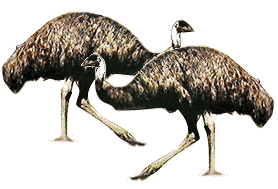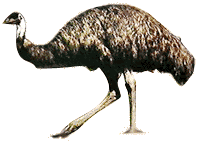The Centrifugal Molecular Distillation Step In Processing Emu Oil
by David Casilio
 Emu oil is derived from the fat of an emu bird. The emu oil has good penetrating properties into human skin due to its high linoleic content plus it is naturally bacteriostatic. A number of health related products are becoming available to the general public in the form of processed oil for burn patients, hand lotion, therapeutic creams, soaps and shampoo.
Emu oil is derived from the fat of an emu bird. The emu oil has good penetrating properties into human skin due to its high linoleic content plus it is naturally bacteriostatic. A number of health related products are becoming available to the general public in the form of processed oil for burn patients, hand lotion, therapeutic creams, soaps and shampoo.
Processing of the oil has been challenging. Initially, the oil has an offensive odor and a brown color typically caused from protein sources such as bones and blood. Headland Oil Processing Company, (HOPCO) wanted to refine the odor and color in a natural physical way as oppose to a caustic reaction. They also wanted to do this on a pilot scale to allow small ranchers of the emu to be able to process their own birds and receive their oil in return. Previously, processors would mix all of the different ranch birds together, then divide up the oil on a percentage of how many birds were brought in. Since the bird’s diet and lineage will dictate the quantity and the quality of the oil, the producers wanted to get the oil only from their birds.
HOPCO, decided to build a small operation. The process starts with removing the fat from the bird and blending. Typically about 20 pounds of fat can be removed from each bird. The fat is then put into a heated tank and brought to 150º F very quickly to reduce peroxide growth. Then it’s stirred for about 20 minutes. The heat melts the fat into an oil and the oil is then strained to remove crackling. It is then run through a finer filter before going to the rendering tank. In the rendering tank, it is mixed with diatomaceous earth and absorbing clay. The clay absorbs the peroxide and refines the color and the diotonatious earth helps to filter the oil. Depending on the peroxide level, the oil may be run through the rendering tank a number of times. The tank is kept at a slight vacuum to reduce peroxide growth.
To remove the odor and not destroy the penetrating properties of the oil requires a special distillation process that lowers the pressure, which therefore lowers the evaporation temperature. After trying other vacuum distillation techniques, it was found that a high vacuum centrifugal molecular still gave the best results. The still was used to make a light end cut of about 3-5%. Tocopherals are used as a preservative and are added prior to distillation.
The Myers Vacuum model Pilot 15 was chosen for its compactness, easy connections, and mobility. This system was found to be better than other types of vacuum stills because of the very short residence time on the heated surface. The Pilot 15 processed about 4-5 gallons per hour. Larger systems are available for scaling up.
 High vacuum centrifugal molecular distillation is a process designed for separating heat sensitive, high molecular weight material. It features applying a very thin, continuously moving film on a heated rotor under high vacuum and placing a condensing surface a short distance away. The residence time on the heated surface is measured in parts of a second. This allows the user to make very fine cuts with the least amount of decomposition from heat.
High vacuum centrifugal molecular distillation is a process designed for separating heat sensitive, high molecular weight material. It features applying a very thin, continuously moving film on a heated rotor under high vacuum and placing a condensing surface a short distance away. The residence time on the heated surface is measured in parts of a second. This allows the user to make very fine cuts with the least amount of decomposition from heat.
Material enters the Pilot 15 using a variable speed gear pump. This will regulate how thick the film will be on the rotor. Material flows from the pump into a falling film degasser chamber. A mechanical pump with a liquid nitrogen cooled trap pumps the heated degasser chamber. The fluid from the degasser enters a second transfer pump and is pumped to the high vacuum chamber. A liquid nitrogen cooled trap, an ejector diffusion pump with a mechanical pump backing it, pumps the chamber. Material is routed to the center of the rotor, which in this case is heated to 390º F. The material spreads out in an exponentially expanding manner to give maximum surface area in the shortest time. Light ends, in this case odors, evaporate off and are condensed on the water-cooled condenser where they are drained and pumped out by the distillate pump. The oil that did not evaporate, runs over the edge of the rotor and is collected by the residue pump. 3-5% of the original material is removed as light ends. They are either collected in the liquid nitrogen traps or in the distillate tank. Approximately 5 gallons per hour can be processed continuously through the Pilot 15.
In conclusion, the whole refining process requires constant vigilance to minimize odor. The key step of removing odors is utilizing the Myers centrifugal molecular still with its short residence time on the heated surface.
About the Author: David Casilio earned a BSEE from Clarkson University in 1980. He was with CVC as a senior project engineers in thin film evaporation. He received a Masters of Science in manufacturing technology in 1990 from Rochester Institute of Technology. He joined Myers Vacuum as vice president in 1994. He manages the Rochester production facility and is in charge of sales of the distillation product line.

